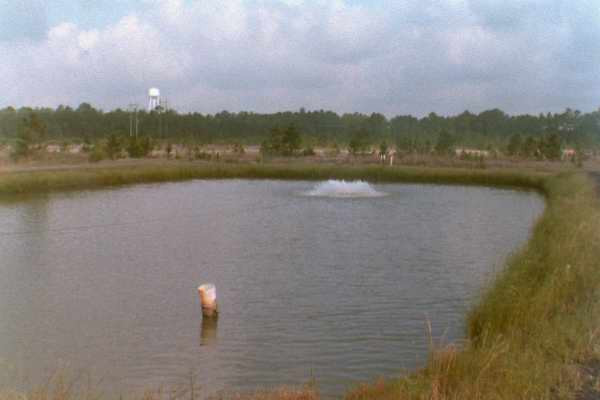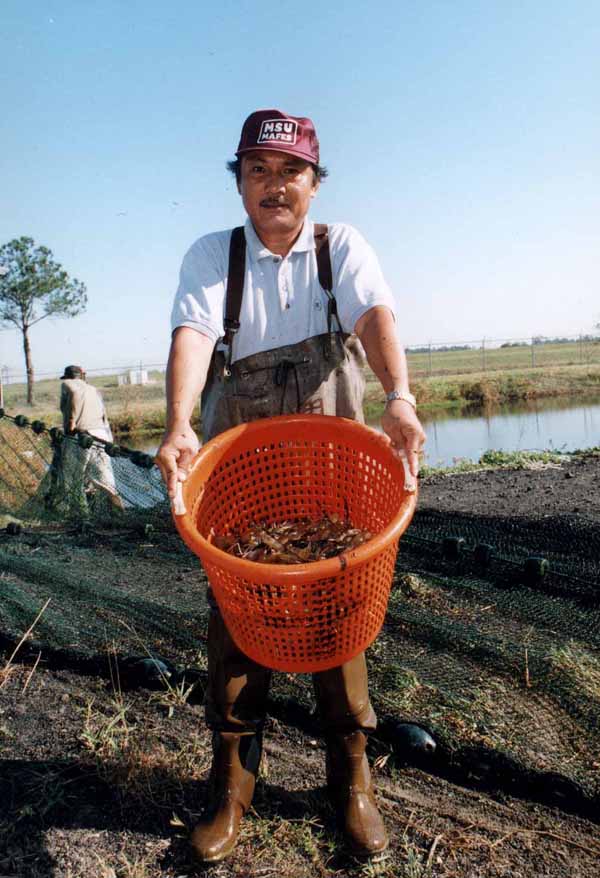The MSU-Coastal Research and Extension Center in cooperation with International Custom Pack, Inc.-Aquaculture Division, conducted experiments using horizontal artificial substrates in intensive pond culture of freshwater prawns in quarter-acre ponds at the MSU-Coastal Aquaculture Unit. Six 1/4-acre ponds were used in the initial experiment starting in July 6, 1999. Artificial substrates covering 50% of the bottom area were installed in each of three treatment ponds.  These substrates which were made of 1/4-inch mesh plastic netting were constructed in rectangular modules 7 ft wide and 214 ft long. Each module was installed across the pond bottom with 5 ft pvc pipes laid every other 10-ft horizontal distance. One layer of plastic netting was tied to the pvc pipes in pre-drilled holes at the troughs of each 10-ft wave. Monofilament lines were used to raise the crest of each 10-ft wave to 1 ft below the water surface. Each of these modules had an area of 1,500 sq ft or 25% of the pond bottom area. Two of these modules were installed in each of the three treatment ponds.
These substrates which were made of 1/4-inch mesh plastic netting were constructed in rectangular modules 7 ft wide and 214 ft long. Each module was installed across the pond bottom with 5 ft pvc pipes laid every other 10-ft horizontal distance. One layer of plastic netting was tied to the pvc pipes in pre-drilled holes at the troughs of each 10-ft wave. Monofilament lines were used to raise the crest of each 10-ft wave to 1 ft below the water surface. Each of these modules had an area of 1,500 sq ft or 25% of the pond bottom area. Two of these modules were installed in each of the three treatment ponds.
During the second 120-day grow-out experiment which started in June 15, 1999, nine 1/4-acre ponds were used consisting of three control ponds, three ponds with added 50% artificial substrates and three ponds with added 75% artificial substrates.  The same substrate materials were constructed in rectangular modules 7 ft wide and 54 ft long. Each module was installed across the pond bottom with 5 ft pvc pipes laid every other 10-ft horizontal distance. Each of these modules covered about 6.25% of the pond bottom area.
The same substrate materials were constructed in rectangular modules 7 ft wide and 54 ft long. Each module was installed across the pond bottom with 5 ft pvc pipes laid every other 10-ft horizontal distance. Each of these modules covered about 6.25% of the pond bottom area.
Each 1/4-acre pond was stocked with 9,000 45-day-old postlarvae weighing about 0.1 g each and harvested after 120 culture days. Sinking catfish feed with 32% protein were broadcast along four sides of each pond two times daily. The feeding schedule was computer generated by staff of the MSU-Department of Fisheries and Wildlife (DFW). Dissolved oxygen and temperature were monitored twice each day while salinity, pH, total ammonia, nitrogen and nitrite were measured on a biweekly basis. All of the ponds used in the experiments were equipped with 1-hp electric aerators.
Freshwater prawn harvest results during the initial experiment showed that the use of horizontal substrates improved freshwater prawn production. 
The production risks involved in freshwater prawn culture were shown by the results of the two-year study. Large variations in survival rate, count and yield were observed in all treatments. The combined results showed that the use of 50% added substrates may lead to improvements in intensive pond production of freshwater prawn. At 50% added growing area, results indicate that more prawns survived and more pounds of prawns were harvested for the same amount of feed consumed. The two-year experimental results showed that to some extent the use of horizontal artificial substrates may lead to improvements in survival, yield, count and feed conversion in intensive freshwater prawn pond production. These improvements in production can be translated into lower average cost of producing freshwater prawn.
